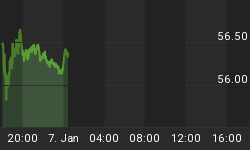John Williams, President of the Federal Reserve Bank of San Francisco, delivered a risk-friendly speech in Portland, Oregon on Thursday. From the Wall Street Journal:
"This is a period when extraordinary vigilance is demanded," Mr. Williams said. "We stand ready to do what is necessary to attain our goals of maximum employment and price stability," the central banker said. Should the Fed need to do more, "the most effective tool would be additional purchases of longer-maturity securities, including agency mortgage-backed securities."
As the odds increase of getting at least a QE hint from the Fed in a few weeks, the recent six day sell-off has featured waning downside momentum and numerous bullish divergences on 60-minute charts. We have discussed divergences between MACD and price many times in the past. Along with MACD, On Balance Volume (OBV), and the Accumulation/Distribution indicators have also been flashing "a rally may be coming" signals on numerous ETF charts. The text below, from stockcharts.com, describes how OBV can assist investors:
On Balance Volume (OBV) measures buying and selling pressure as a cumulative indicator that adds volume on up days and subtracts volume on down days. Chartists can look for divergences between OBV and price to predict price movements.
Accumulation/Distribution can be used in a similar manner:
The Accumulation Distribution (Accum/Dist) Line is a volume-based indicator designed to measure the cumulative flow of money into and out of a security. Chartists can use this indicator to affirm a security's underlying trend or anticipate reversals when the indicator diverges from the security price.
If divergences between price and an indicator can be used to "anticipate reversals", it may be a good time to start the anticipation process. Clear bullish divergences between the three indicators and price can be seen by comparing the slopes of lines A, B, C, and D on the 60-minute S&P 500 chart below.

The divergences shown here are shorter-term in nature. They compliment longer-term bullish developments outlined in a July 8 video.
Since quantitative easing injects freshly printed dollars into the global financial system, investors tend to migrate toward inflation-protection assets before and during a round of QE. The short-term divergences in silver (SLV), copper (JJC), mining stocks (XME), and oil service companies (OIH) align with a market that may be preparing for Fed action.




With the situation in Europe continuing to drag on and on, the markets may get more intervention from the European Central Bank (ECB). From Reuters:
European Central Bank policymakers held out the possibility on Thursday of taking further measures to boost the flagging euro zone economy after a cut in their deposit rate to zero showed no sign of jolting banks into lending out more money. Faced with fading inflation pressures and no sign banks are about to funnel more money to business to help the stagnating economy, ECB policymakers signaled they could act again. "Should the situation deteriorate, there is no article of faith preventing us from going below 0.75 percent," said ECB Governing Council member Klaas Knot.
The EAFE ETF (EFA) has exposure to France, Germany, and Spain. Thus, it is not surprising EFA has short-term divergences, keeping a bullish reversal on the table.

France is saying "don't rule out a rally attempt".

Back in the United States, large-cap (IWV) and large-cap value stocks (IWD) are also hinting at the possibility of an imminent rally attempt in risk assets.


If you are expecting a possible rally in stocks and commodities, it is helpful to see if safe haven assets are flashing possible reversal signals as well. As shown below, Treasuries (TLT) and the short S&P 500 ETF (SH) are exhibiting negative or bearish divergences.

Many traders do not want to be short when intervention and press conference risk are so high. Central banks can change the rules at any time, including Sunday.

As we have stated in the past, divergences alone are not a reason to buy anything. Divergences are "pay attention" and "keep an open mind" signals. When they are present, it is also easier to hold onto your long positions. Divergences can be removed from a chart based on future price action, but as long as they remain, the bulls probably have more hope than most believe. Headline-driven markets can do anything at anytime, including ignore every divergence presented here. Therefore, it is prudent to understand where long-term support resides. The chart of the NYSE Composite Index below could come in handy should the recent bearish trends accelerate.

When signals appear in numerous markets and across different asset classes, they tend to be more meaningful. There are too many ETFs with similar set-ups to show them all, but below is a sampling for your viewing pleasure.























